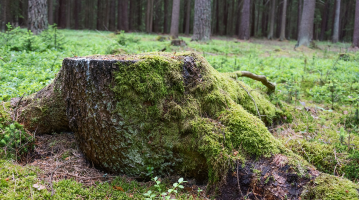10 steps to preserve biodiversity
Biodiversity is all around us. We depend on it working properly to eat, breathe, drink, clothe and house ourselves. Preserving biodiversity might seem like a gargantuan task, but we can all do our bit to make our daily lives more of a shield against further damage. And it doesn’t take much.
By making simple changes to how much we consume, thinking carefully about our next holiday, opening our eyes and ears to what’s happening all around us, each and every one of us can play an important role.
Everyone can do their bit to preserve biodiversity. There’s no such thing as a small or insignificant gesture when it comes to saving living things! Here are 10 steps you can take to adapt your daily routine to become a little more in tune with the needs of the planet.
Reduce your waste
When we throw things away, it might be a case of out-of-sight, out-of-mind, but we should never forget that our waste sticks around for a very long time, and can actually have a considerable effect on the planet. Our consumer choices are essential to reducing waste. This starts with buying only what we really need, repairing things rather than throwing them straight in the bin, buying second-hand rather than new all the time, choosing products that can be used again and again, rather than single use items, and so on. You can also push back against over-packaging in your daily routine by choosing to buy in bulk, making your own household products, or choosing products with recycled/recyclable packaging, even no packaging at all... Finally, you can contribute to the waste management effort by checking your local authority’s sorting instructions, finding out more about recycling channels for those hard-to-recycle products, composting your organic waste, etc. There are plenty of ways to reduce your footprint and limit the amount of waste that ends up in nature, further contributing to the destruction of habitats.
Consume better
Our best weapon in the fight to preserve biodiversity? Our wallet! Every day, through the consumer choices we actively make, we can opt for more responsible alternatives without depriving ourselves! When it comes to food, eating organic, local and seasonal produce means contributing to an agrifood system that respects biodiversity. You could also reduce the amount of meat and fish you eat in favour of higher quality animal proteins. Read the labels on the things you buy, looking at their composition and origin, valuable pieces of information to help guide your choices! For everyday items, resist the temptation of ultra-fast deliveries that only add to your carbon footprint and opt to shop locally instead. Also think about reducing your digital footprint by regularly cleaning out your email inbox, reducing the quality of online streams, and opting to send links rather than large files. All those virtual bytes have a very real weight in natural resources!
Garden greener
Ah, the joy of growing something with your own two hands! Whether you have a large garden or just a small space on a windowsill, you can still help biodiversity in your own way.
– Vary the species you grow and choose those suited to the climate to avoid wasting water unnecessarily!
– Limit your use of plant protection products in favour of natural alternatives.
– Incorporate mulching to conserve soil moisture and limit your water consumption by installing a water butt to collect the rainwater.
– Welcome pollinators and small fauna by diversifying your flora and leaving a few quiet spots.
– Limit grass cutting, especially in the summer months. The grass cover will protect your soil, retain moisture better and provide a cool haven for all those little animals that wander into your garden.
– Adopt a permaculture approach, choosing species that help each other to reduce the need for intervention and allow biodiversity to thrive in harmony. Essentially, the less you do in your garden, the better!
Limit your water consumption
The water cycle is an integral part of balanced ecosystems. The lives of animal and plant species depend on this water supply. Consuming water responsibly also means you’re helping to protect the planet’s biodiversity. There’s the water we use directly from the tap when we brush our teeth or wash the dishes, when we take a shower or bath, when we flush the toilet, when we switch on the dishwasher or washing machine, and when we water the garden. Adopting responsible behaviour means first and foremost being aware of your habits so you can adjust them more effectively. You could opt for flow reducers on your taps, switch to the dishwasher or washing machine cycles that consume the least water, reduce the amount your toilet gets flushed every day, switch to drip irrigation in the garden or even to a drought-resistant garden... And then there’s the water we consume indirectly, i.e. the water used to make the products we consume. To reduce your consumption here, you could try switching to solid toothpastes, shampoos bars and soap bars, buying mouthwash tablets, looking for more responsible cosmetics, buying washing and shaving wipes... there’s no shortage of choice these days when it comes to switching to more planet-friendly alternatives!
Save energy
Producing energy is far from neutral for ecosystems. The more we use, the more our supply networks have to grow, fuelling deforestation and destroying wetlands. Energy is the lifeblood of our daily lives, but there are many ways we can reduce our footprint. Think about turning down the heating or air conditioning, turning off the lights, not leaving computers on standby, unplugging appliances when you’re not using them, switching to low-energy light bulbs, opting for more energy-efficient appliances, and so on. But also be aware of how the energy you consume is produced and make informed choices, like choosing a “green” supplier or a more responsible mix.
Get around on foot, by bike or on public transport, rather than by car
Transport accounts for a third of all greenhouse gas emissions. But cars are also a source of air and soil pollution, as well as noise pollution, which damages ecosystems. Soft mobility is increasingly encouraged and available (cycle paths, intermodality, reduced speed zones), so try to make the most of it for your occasional or everyday journeys! For those who simply can’t do without a car, think about car sharing schemes or carpooling. As well as the social benefits, it takes more cars off the road! For longer journeys, take the train or other forms of public transport.
Travel responsibly
Good habits don’t have to stop when you head off for a week in the sunshine. Travelling means stepping foot into other ecosystems that need just as much care and attention as those you encounter on a daily basis. And the same rules apply. Value local products, be careful about water and energy consumption, reduce the amount of waste you produce, etc. But it’s also about choosing activities that are eco-friendly or have a limited impact on the natural environment, finding out about the best practices to adopt, like the best nature trails to explore, and which to leave alone, how to behave towards the local flora and fauna , not taking the risk of introducing potentially invasive species, only touching with your eyes, not your hands (imagine you’re talking to a toddler heading for a priceless antique) and refraining from collecting wild plants, even if it’s for your herbarium back home. Don't see this as a constraint! On the contrary, thinking this way will help you learn more about the new places you visit and make your trip even more enjoyable!
Get involved
Being a citizen means having a say in decisions. Preserving biodiversity isn’t the prerogative of the elite, it’s everybody’s business. You could join a local biodiversity association to protect the ecosystems you see every day. Or why not join a collective that manages a shared garden? Or launch one yourself! Make your voice heard. Ask your local councillors about their biodiversity plans, take part in public meetings, find out what’s being done – or needs to be done –, draw attention to areas where more action is needed... There’s a reason why grassroots movements are called “grassroots”!
Educate yourself
Biodiversity represents an inexhaustible source of knowledge. And because we can only protect what we know about, there’s no reason why we shouldn’t continue to educate ourselves about biodiversity! There are plenty of excellent resources available. Give preference to official sources, such as local biodiversity agencies, government websites or NGOs that have been fighting this battle for years. Find out about local programmes and events. Many museums, conservatories and associations organise discovery tours, lectures and guided walks to help people discover the ecosystems around them. And do your best to pass on the knowledge “bug” to those around you – there are tools and resources for all ages and interests!
Marvel at nature
Don’t forget that nature is the realm of wonder, from the infinitely small to the infinitely big, it’s a relationship that nourishes the soul. Open your eyes and practice being aware of your surroundings from the moment you step outside. There’s no need to trek for days through the Amazon jungle! Biodiversity is all around you! A recognizable bird’s chirp, a paw print in a muddy puddle, a nest hidden beneath a roof tile, a wild flower between two paving stones... there’s no shortage of opportunities to take a break from our hectic lives and recognize the beauty that surrounds us!

Causes and consequences of deforestation
Find out more about the threats to biodiversity and how to preserve it

Discover botany
Find out more about our educational packs for a gentle introduction to botany and how to cultivate your passion for plants!
